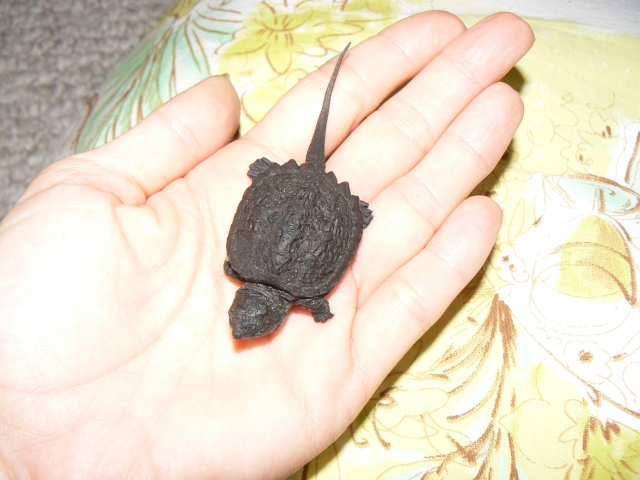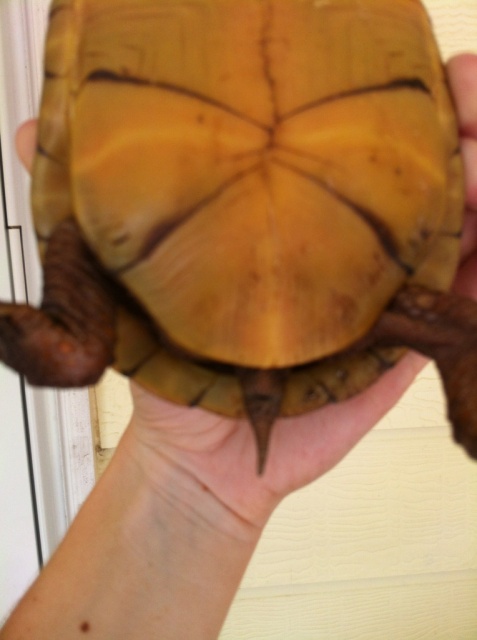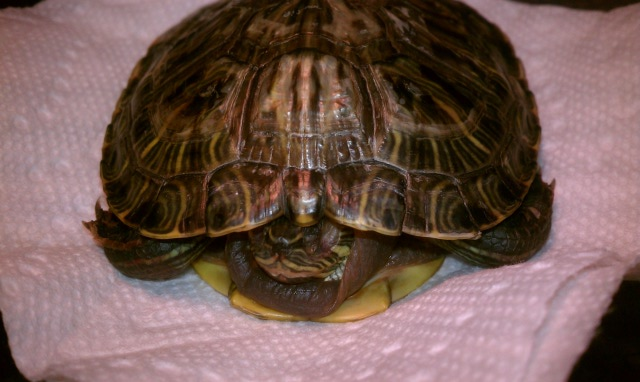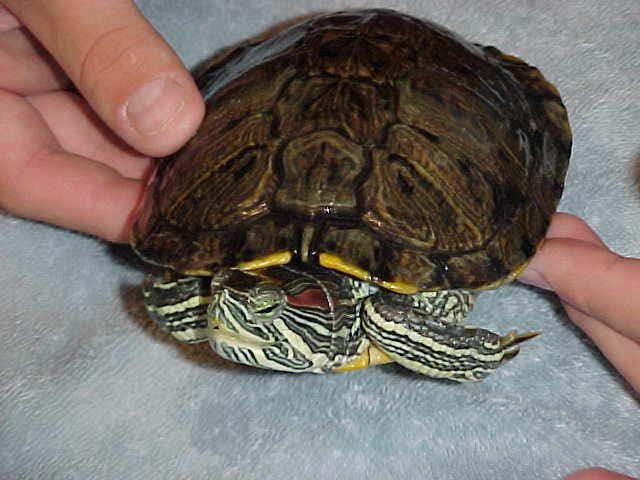QuestionQUESTION: Hello, I have a Russian tortoise who is attempting to mate with a newly acquired Redfooted tortoise of mine. Is it possible for them to copulate?
ANSWER: Hi Phil,
It's possible that they would mate, but the more important answer to your question is that species should not be mixed for health reasons--and even more importantly, Russians and redfoots have completely different habitat and dietary needs and should not be cohabitating. Russians are herbivores and need an environment that has some humidity but isn't actually moist, and redfoots are tropical omnivores that require a moist habitat that has some boggy areas. Russians should have a diet of leafy greens and weeds. They shouldn't have fruit or vegetables. Redfoots need a base diet of greens, with fruit/veggies a few times a week and some kind of animal protein about once a week.
So my advice would be to separate your tortoises ASAP and get them into the right habitats for their health and safety. Below are some links to websites with proper care information:
www.russiantortoise.org
www.redfoottortoise.com
www.tortoiseyard.com
---------- FOLLOW-UP ----------
QUESTION: I should have clarified my initial question. My tortoise live in a very large indoor enclosure outfitted with several different compartments where different habitats are made available, ranging humidities and temps per the requirements of the species. Also the different habitats have different foods and substrates, mercury vapor ballasted uva/uvb outputs, and even misting systems to help provide humidity to the tort that needs it (the red foot). Their diets are completely different and are monitored quite fastidiously by myself so that I know for sure which tortoise is getting what food. All food is supplemented with the proper ratio of Ca/P and small amount of D3 to be matabolized by the uv lighting. Both have a clean vet bill based on fecal samples.
Thank you much for your speedy and knowledgable response! But I have just a few more questions!
To clarify, my redfooted tortoise can lay fertalized eggs by my russian tortoise as the male?
How long after copulation can one expect to see eggs / egg burrowing behaviior?
How long to hatch?
And lastly where can I find proper data on what temperatures will sex the eggs in case I choose to have males and females.
Thanks again for all the information!
ANSWER: Hi Phil,
I need to reiterate that this is a very bad idea. All species carry pathogens that are unique to that species and to which they have immunities that other species don't. Introducing new specimens of the same species is risky enough, even after a lengthy quarantine. Introducing specimens of two different species should only be done if you're willing to lose all your tortoises. In particular, because mature Russian tortoises in this country are all wild caught (unless you got yours from a private breeder who's been breeding for some time), and recent imports often carry the herpes virus, the risk is very great. The herpes virus can lay dormant for years and then wipe out entire groups of tortoises.
The second question is why you would even want to attempt this. The offspring, if there were any (and one would hope that nature would prevent such an eventuality), would be complete anomalies--you would have no idea how to properly care for them. What kind of habitat would they need? What kind of diet? The only way to find out would be to play with the hatchlings' lives, and that is not responsible breeding.
As far as your other questions, I really can't answer them. I've never heard of such a breeding attempt--responsible breeders aren't interested in hybrids--so you'd have to do your own experimentation. There's plenty of breeding information online for the two species, but no way to say how the two would combine. And as I sais, it's not something anyone who really cares about species preservation would even consider.
---------- FOLLOW-UP ----------
QUESTION: Jeannie,
Thanks again for the thorough and timely response.
I will begin constructing a permanant partition between the two habitats in short order. My chief concern is always the health and well being of my pets, and the healthy perpetuation of the species, not to make money or hoard tortoises. My goal was/is never to breed in any capacity. I suppose I was just excited at the prospect of some of my tortoises' mating.
Do you have any information off hand or a link too some african spur thigh breeding? Ages for sexual maturity (unless its based on size and weight). And also questions I asked previously but as they pertain to my african spur thighs.
Thanks,
Phil
AnswerHi Phil,
Thank you for reconsidering this. It's really best for the health of your tortoises, and in any case, I think the outcome of any attempted breedings would be doubtful.
Similarly, I'd advise against breeding your sulcata. Because they're so large and require so much room, they're rapidly becoming throwaway pets and wind up abandoned or in rescue on an increasing basis. They're also very prolific, and you might very well be seeing multiple clutches a year for several years just from putting a pair together for a month or so. That sounds like fun, but I can tell you from experience that caring for just a few hatchlings is quite a bit of work and it often takes some time to find good homes for them--and with sulcata you'd want to screen very carefully.
I'd suggest breeding Russians, if you're interested in breeding. They're smaller, so finding appropriate homes is easier, and they're not overly prolific so you won't be inundated with hatchlings. If you have healthy adults that are housed well and given a good diet, breeding isn't difficult, and incubating/hatching the eggs isn't hard, either. I've had a 100% hatch rate with my viable eggs. The other reason I recommend breeding Russians is that they're still wild caught and imported into this country under pretty terrible conditions, so the more captive breeding there is the closer we get to significantly reducing the strain on the wild population.
You would need a breeding group of at least one male and two females. This is to prevent a single female from being harassed by the male. Some people think that two males increases the fertility rate, but I've known people who produced hatchlings successfully with just one male. Just be sure that any females you get are big enough to make sure they really are female; 5" or larger should be good (and don't forget to quarantine). I think it helps if the tortoises are kept outdoors during the warmer months, so they can get natural sunlight and graze. They are pretty hardy outdoor tortoises. My Russians will mate constantly in the spring, but they'll also mate throughout the year if kept indoors and awake during the winter. Eggs are laid roughly four to six weeks after breeding activity commences, and then hatching is eight to ten weeks after the lay date. Incubation at about 89 degrees will produce mostly females, and at 84 degrees mostly males. An in-between temperature will result in a mix of males and females. Don't go over 90 degrees as shell deformities can result. I keep the humidity at about 70%.
Hope that helps. Let me know if you have any other questions.

 hatchling snapper
Question
Whipper Snapper
hey mark... this site is great
hatchling snapper
Question
Whipper Snapper
hey mark... this site is great
 flakey substance on turtles neck and legs
Question
Red ear slider
red ear slider about 9 mos. 20
flakey substance on turtles neck and legs
Question
Red ear slider
red ear slider about 9 mos. 20
 male or female box turtle?
Question
box turtle
Is this a male or female box
male or female box turtle?
Question
box turtle
Is this a male or female box
 RES turtle being treated for Septicemia
QuestionQUESTION: Hello,
I have a RES turtle being tre
RES turtle being treated for Septicemia
QuestionQUESTION: Hello,
I have a RES turtle being tre
 Species ID
Question
Red eared turtle Red eared Turtle
Species ID
Question
Red eared turtle Red eared Turtle